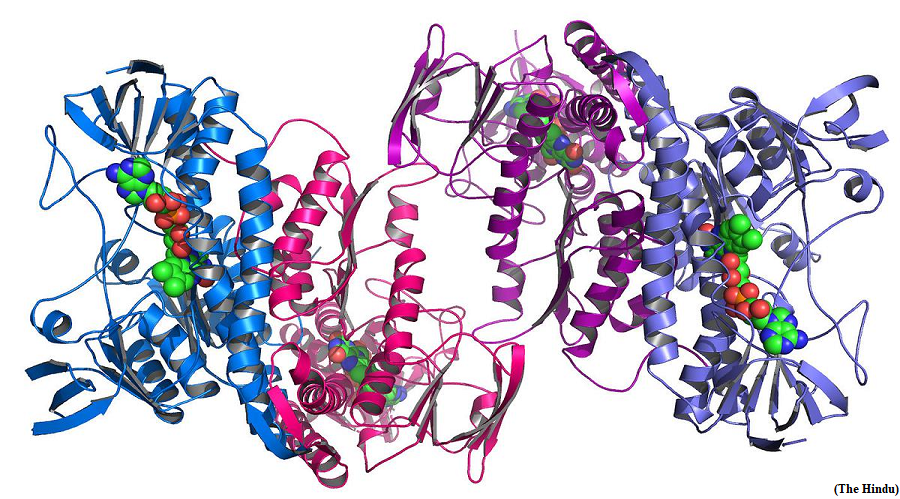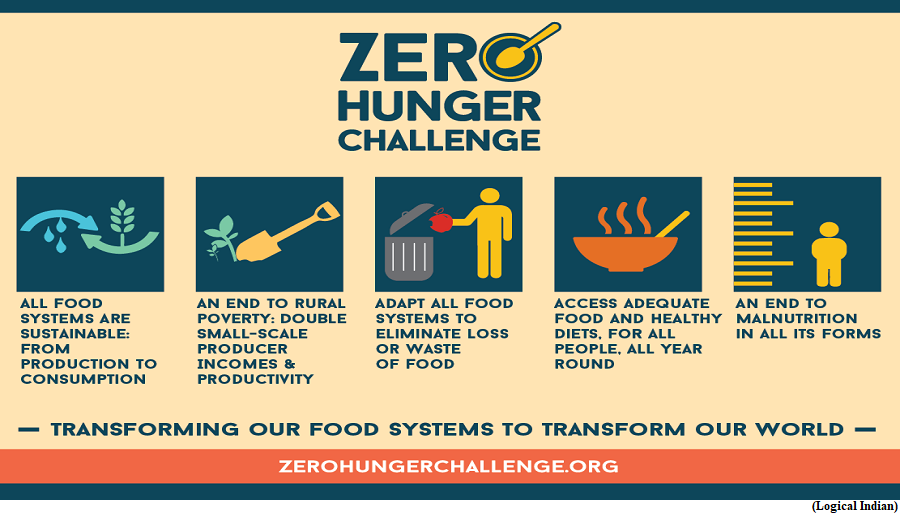In AI unlimited potential, the benefits and the risks (GS Paper 3, Science and Technology)

Why in news?
- Recently, Google’s DeepMind released the structure of 200 million proteins, literally everything that exists. This is said to be the most important achievement of AI ever, namely a ‘solution’ to the protein-folding problem.
Why it matters?
- Proteins are composed of a linear chain of amino acids and their 3D structures determine their functions. Structure determination is laborious.
- One way to know the optimal folded structure of the protein computationally is to sample all its possible configurations, composed of specific angles between peptide bonds.
- However, this is an impossible task as a typical protein may have about 10,300 configurations and even if a million of them were examined per second, the overall time needed will be unimaginable. That helped save about 1,000 million man-years.
- DeepMind’s AlphaFold made an important breakthrough in 2020. It accurately predicted the structures of about 100 proteins to atomic resolution, and no other solution came close to this feat. Many believe that the protein-folding problem is over.
Drug discovery:
- Already, this has assisted the Drugs for Neglected Diseases initiative (DNDi) in addressing deadly Chagas disease and Leishmaniasis.
- Since drug discovery has become faster due to AlphaFold, new drugs for rare diseases, which are of little commercial interest to pharma companies, have become possible.
Other benefits:
- In 2020, a robotic synthesiser read a research paper and made the compound described in it. With giant advances in computational science and 3D protein structures, discovery labs will shrink to ‘AI synthesizers’.
- Thousands of molecules or processes may be screened for specific functions rapidly. Robots will characterise them to ‘discover’ an optimised strategy, directed by non-human ‘agents’. This could change chemistry.
- The UNEP’s World Environment Situation Room (WESR) collects and analyses, using AI, real-time sensor data from thousands of sensors spread over 140 countries to predict carbon dioxide concentration, glacier mass, sea level rise, biodiversity loss, etc.
New risks:
- Scientists warn that AI products must be used with caution. Tools such as ChatGPT can assist in literature search but cannot provide deep analysis and may miss profound insights central to articles.
- Intrinsic biases of scientific enterprise can under-represent minority views and could lose original thoughts, due to poor citations. Some journals have suggested authors to declare the use of AI tools in publications and have discouraged ChatGPT from being an author, with exceptions.
- However, AI can be an excellent aid in helping authors in better visualisation, effective communication and compiling known facts, if used judiciously.
Way Forward:
- Governments at all levels must urgently assess the impact of AI on societies. They must form advisory groups and come up with AI and data-governance policy guidelines to direct institutions, industry, and society.
Can new data panel improve India’s statistics?
(GS Paper 3, Economy)
Why in news?
- The Ministry of Statistics and Programme Implementation has formed a new Standing Committee on Statistics (SCoS) to advise on official data generated by the National Statistical Office (NSO).
- This panel, chaired by former National Statistical Commission chief and India’s first Chief Statistician Pronab Sen, will replace another committee headed by him that was formed in 2019 to advise on economic data.

What is different about the new committee?
- The Standing Committee on Economic Statistics was mandated to review the framework for economic indicators such as those pertaining to the industrial and services sectors, along with labour force statistics.
- This meant its focus was limited to reviewing high-frequency data like the Index of Industrial Production (IIP) and the Consumer Price Index (CPI), apart from surveys and enumerations like the Economic Census, Annual Survey of Industries and the Periodic Labour Force Survey.
- The SCoS, has “enhanced terms of reference” that enable it to advise the Ministry not just on all existing surveys and data sets, but also identify areas where data gaps exist, suggest ways to fill them and carry out pilot surveys and studies to finetune new approaches for capturing better data.
- The new committee is also half the size of the 28-member panel that was reviewing economic data.
Why does it matter?
- In recent years, the credibility of some of NSO’s data, especially the results of various household surveys traditionally carried out by the National Sample Survey Office (NSSO) have come under a cloud, with even top government officials questioning their approach and outcomes.
- In 2019, the government had decided to junk the results of two major NSSO household surveys carried out in 2017-18, to assess the employment and consumption expenditure levels in Indian households by claiming they suffered from “data quality issues”.
- The actual rationale for withholding the outcome of the last surveys, carried out soon after demonetisation and the implementation of the Goods and Services Tax (GST), is believed to be that they revealed distress in households.
How can the SCoS bridge the trust deficit surrounding official data?
- While it can advise the Statistics Ministry on individual surveys and data sets, the new panel is also expected to help address issues raised “from time to time” on the results and methodology of surveys.
- With survey design and features evolving, the panel can seek to sensitise data users about the nuances involved to ensure better interpretation of the numbers.
- The SCoS, which will help the NSO finalise survey results and, the independent National Statistical Commission that is empowered to assess whether any official data is fit for release, must seek to rebuild the credibility of India’s statistics.
What has to be done to get to Zero Hunger?
(GS Paper 3, Economy)
Why in news?
- The Global Report on the Food Crises (GRFC) 2023 released recently estimated that between 691 million and 783 million people in the world suffered from hunger in 2022.

Details:
- While the two pandemic years did not record a growth in food insecurity, the data for 2022 shows levels far higher than pre-pandemic 2019.
- The 2023 report records the historic moments that had an impact on the assessment — a pandemic and ensuing economic crisis, a war (in Ukraine), soaring prices of food, and agricultural inputs.
About GRFC:
- The GRFC is produced by the Food Security Information Network in support of the Global Network against Food Crises, and involves 16 partners to achieve a joint consensus-based assessment of acute food insecurity in countries.
What is food security?
- Food security is defined (from the World Food Summit of 1996) thus: “When all people, at all times, have physical and economic access to sufficient, safe and nutritious food that meets their dietary needs and food preferences for an active, and healthy life”.
- The prevalence of moderate or severe food insecurity in the population is based on the Food Insecurity Experience Scale (FIES).
What are the key findings?
- The Global Report starts with a qualified assertion that hunger is no longer on an alarming path upwards at the global level, but still far above pre-COVID pandemic levels, and that the world is far off track towards achieving Sustainable Development Goal 2 — Zero Hunger.
- It sets the global contexts preceding and during the year under assessment, particularly paying attention to the increasing phenomenon of urbanisation, and its effects on food security.
- In 2022, an estimated 2.4 billion people did not have access to adequate food. This is still 391 million more people than in 2019.
Undernourishment, stunting & child wasting:
- Global hunger, measured by yet another metric, the prevalence of undernourishment remained relatively unchanged from 2021 to 2022 but is, again, far above pre-COVID-19-pandemic levels, affecting around 9.2% of the world population in 2022 compared with 7.9% in 2019, according to the report.
- Stunting defined as the condition of being too short for one’s age, among children under five years of age has declined steadily, from 204.2 million in 2000 to 148.1 million in 2022.
- Simultaneously, child wasting, caused by insufficient nutrient intake or absorption, declined from 54.1 million in 2000 to 45 million in 2022. In terms of children who are overweight or obese, the study indicated a non-significant increase from 5.3% (33 million) in 2000 to 5.6 % (37 million) in 2022.
- The revised analysis presented in 2023 report shows that almost 3.2 billion people worldwide could not afford a healthy diet in 2020, with a slight improvement in 2021.
- The cost of a healthy diet increased globally by 6.7% between 2019 and 2021. It also projects that almost 600 million people will be chronically undernourished in 2030.
What are the solutions ahead?
- The sound nutrition is fundamental to the achievement of the Sustainable Development Goals and must be central in government policy and supported by civil society and the private sector.
- Some of its recommendations include supporting healthier food outlets as key for enabling access to healthy diets. Policy incentives are necessary to encourage shops to sell greater amounts of fresh and minimally processed foods.
- Another key input is on street foods, which an estimated 2.5 billion people worldwide consume every day, due to the convenience and cost factor. The report calls for addressing multiple infrastructure and regulatory gaps to improve nutritional safety and quality of street food.
- The GRFC also suggests building rural infrastructure, including quality rural and feeder roads to connect remote farms and enterprises to main road networks.
- Other public investments to support linkages between (mainly small) farms and small and medium enterprises could include warehousing, cold storage, dependable electrification, access to digital tools and water supply.
- It underlines several times the role of local governments as fundamental actors in leveraging multilevel and multi-stakeholder mechanisms that have proved effective in implementing essential policies for making healthy diets available and affordable for all.




